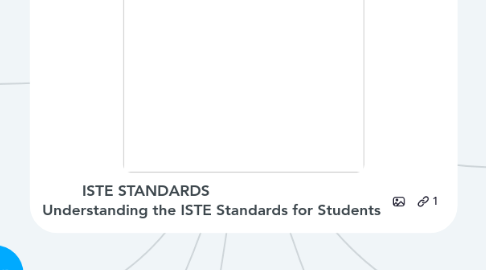ISTE STANDARDS Understanding the ISTE Standards for Students
by Elena Resendiz

1. Digital Citizen
1.1. To be a digital citizen means you are ethical and safe when using technology.
1.2. ISTE standards require students to be conscious of their online reputations.
1.3. According to the ISTE standards students should keep their personal information private and make positive choices.
2. Knowledge Constructor
2.1. Their goal in this section is to build the students research skills.
2.2. Students should be able to make their own conclusions.
2.3. A big challenge at the moment is having the capability to build reliable knowledge bases in order to be good citizens.
3. Innovative Designer
3.1. Thinkers use a step by step process to apply their ideas.
3.2. Students that follow the ISTE standards use a similar process along with the use of digital tools.
3.3. Students using this process develop, test, refine prototypical models, and adapt to complex problem solving.
4. Creative Communicator
4.1. Students need to be able to communicate their ideas and know how to use edtech tools to meet their learning goals.
4.2. This standard includes acts like sharing your ideas with other peers.
4.3. This standard also includes the act of producing complex digital ideas to a target audience.
5. Student learning is the ultimate goal
5.1. The use of ISTE standards will help you keep focused on the students outcomes.
5.2. By using the ISTE standards, you are providing the students with a voice and with choice.
5.3. You are also providing empowerment for them to achieve their educational goals with technology.
6. Introducing the ISTE Standards for Students
7. What is ISTE and how do they benefit students?
7.1. ISTE stands for International Society for Technology in Education.
7.2. Their goal is to "transform teaching and learning through technology".
7.3. The standards are designed to empower students voices and to make sure that learning is student driven.
8. Empowered Learner
8.1. Empowered learners are confident, motivated, and prepared.
8.2. Students should be prepared to lead their learning.
8.3. The Ohio Teacher Evaluation System requires lessons to be student led.
9. Computational Thinker
9.1. Students develop logical descriptions of problems.
9.2. They do this by using edtech tools.
9.3. With these tools they break down, analyze and solve those problems.
10. Global Collaboration
10.1. Students should learn how to use edtech tools to complete a bigger picture.
10.2. They should also expand their cultural horizons
10.3. Lastly, students should know how to participate in collaborative work in school and around the world.


